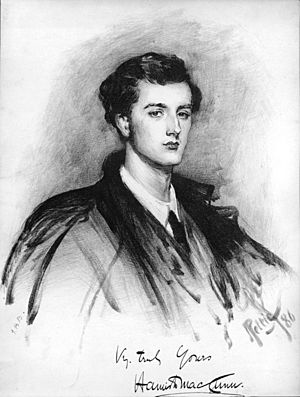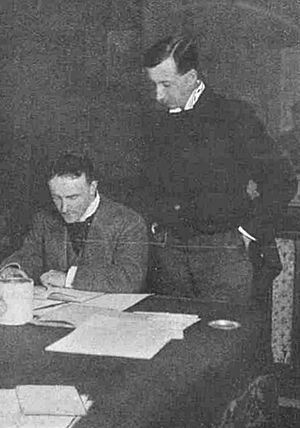Hamish MacCunn facts for kids
Quick facts for kids
Hamish MacCunn
|
|
|---|---|

1889 portrait by John Pettie
|
|
| Born | 22 March 1868 Greenock, Scotland
|
| Died | 2 August 1916 (aged 48) London
|
| Occupation | Composer, conductor, teacher |
Hamish MacCunn, born James MacCunn (1868–1916), was a Scottish composer, conductor, and teacher. He was one of the first students at the Royal College of Music in London.
He quickly became known for his music. His orchestral piece The Land of the Mountain and the Flood (1887) was a big early success. Later, his first opera, Jeanie Deans (1894), was also very popular.
While he kept composing, he became best known as a conductor and teacher. He taught music at the Royal Academy of Music and the Guildhall School of Music. As a conductor, he led famous opera companies like Carl Rosa and D'Oyly Carte. He also worked with the famous conductor Thomas Beecham.
Contents
Hamish MacCunn's Life and Music Career
Early Life and Musical Beginnings
James MacCunn was born in Greenock, Scotland, on March 22, 1868. His family loved music. His father played the cello, and his mother sang and played the piano. They encouraged James's musical talents.
He took private lessons in violin, piano, organ, and composition. When he was eight, his family spent a season in London. There, he attended many concerts at the Crystal Palace. In 1883, at age fifteen, he won a scholarship. This allowed him to study at the new Royal College of Music (RCM) in London.
At the RCM, MacCunn studied piano, viola, and composition. Even as a student, his music was performed. His cantata The Moss Rose was played in 1884. His overture Cior Mhor was performed in 1885. In 1885, he started using the name Hamish, which is a Scottish Gaelic version of James.
He left the RCM in 1886 without finishing his degree. Soon after, he had a big success with his concert overture The Land of the Mountain and the Flood. It was first performed in 1887. Critics praised the piece, calling it "spirited and bold." The famous writer George Bernard Shaw, who was also a music critic, said it was "a charming Scotch overture."
In 1889, Hamish MacCunn married Alison Pettie, the daughter of painter John Pettie. They had one son named Fergus. From 1888 to 1894, MacCunn was a professor of harmony at the Royal Academy of Music. He also taught music to private students.
Opera and Conducting Work
In 1889, Hamish MacCunn was asked to write an opera for the Carl Rosa Opera Company. He also planned to write an opera for Richard D'Oyly Carte's new Royal English Opera House. This opera was based on the novel Cleopatra, but it was never finished.
His opera for Carl Rosa, Jeanie Deans, was finished later. It was based on Walter Scott's novel The Heart of Midlothian. The opera was first performed in 1894 in Edinburgh. MacCunn himself conducted it. It was a great success.
In 1896, Jeanie Deans was performed in London. MacCunn also composed another opera called Diarmid and Ghrine. The next year, his orchestral suite Highland Memories was performed. The Carl Rosa company also presented Diarmid and Ghrine at the Royal Opera House.
After Jeanie Deans, MacCunn became well-known as an opera conductor. From 1898, he was the musical director for the Carl Rosa company for two seasons. He conducted many operas, including the first English versions of Wagner's Tristan und Isolde and Siegfried.
In 1900, he became the conductor for the Moody-Manners company. He conducted a wide range of operas, such as Lohengrin, Carmen, and The Flying Dutchman. In 1902, he became the musical director for the D'Oyly Carte Opera Company. He conducted the first performances of Edward German's Merrie England and A Princess of Kensington.
Later, MacCunn conducted Hansel and Gretel in 1910. He also conducted The Tales of Hoffmann on tour. In 1915, he conducted The Tales of Hoffmann and Faust.
From 1912, MacCunn taught opera classes at the Guildhall School of Music. He also continued to teach privately. Conducting and teaching took up most of his time. He composed fewer works in his later years. Some of his later works include The Masque of War and Peace (1900) and The Wreck of the Hesperus (1905).
Hamish MacCunn became ill in 1916 and passed away on August 2, 1916, at age forty-eight. He is remembered for his beautiful Scottish-inspired music and his important work as a conductor and teacher.
Hamish MacCunn's Musical Works
Hamish MacCunn composed many different types of music, including:
Orchestral Music
- 1885 – Cior Mhor, an overture
- 1886–87 – The Land of the Mountain and the Flood, a concert overture, Op. 3
- 1887 – The Ship o' the Fiend, a ballad, Op. 5
- 1888 – The Dowie Dens o' Yarrow, a ballad, Op. 6
- 1896 – Highland Memories, a suite, Op. 30
- 1900–09 – Four Dances
Choral and Vocal Music
- 1882–84 – The Moss Rose, a cantata
- 1887 – Lord Ullin's Daughter, a cantata
- 1886–88 – Bonny Kilmeny, a cantata, Op. 2
- 1888 – The Lay of the Last Minstrel, a cantata, Op. 7
- 1889 – The Cameronian's Dream, a cantata, Op. 10
- 1891 – Queen Hynde of Caledon, a cantata, Op. 13
- 1900 – The Masque of War and Peace, for solo singers, chorus, and orchestra
- 1905 – The Wreck of the Hesperus, a cantata
- 1908 – The Pageant of Darkness and Light, for solo singers, chorus, and orchestra
- 1912 – Livingstone the Pilgrim, for solo singers, chorus, and organ
- 1896–1913 – Four Scottish Traditional Border Ballads, for chorus and orchestra
Operas
- 1894 – Jeanie Deans, an opera
- 1897 – Diarmid, an opera, Op. 34
- 1905 – The Golden Girl, a light opera
See also
 In Spanish: Hamish MacCunn para niños
In Spanish: Hamish MacCunn para niños


